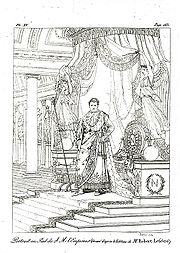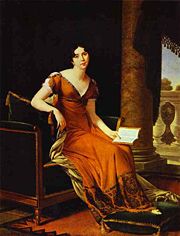
Robert Lefèvre
Encyclopedia


Jacques-Louis David
Jacques-Louis David was an influential French painter in the Neoclassical style, considered to be the preeminent painter of the era...
and his style s reminiscent of the antique.
Life
Robert Lefèvre made his first drawings on the papers of a procureur to whom his father had apprenticed him. With his parents' consent, he abandoned this apprenticeship and walked from Caen to Paris to become a student of Jean-Baptiste RegnaultJean-Baptiste Regnault
Jean-Baptiste Regnault was a French painter.Regnault was born in Paris, and began life at sea in a merchant vessel. At the age of fifteen his talent attracted attention, and he was sent to Italy by M. de Monval under the care of Bardin...
(in whose studio he met and became friends with Charles Paul Landon
Charles Paul Landon
Charles Paul Landon was a French painter and popular writer on art and artists.He was born in Nonant and entered the studio of Jean-Baptiste Regnault, where he made a lifelong friendship with Robert Lefèvre. He and won the first prize of the Academy in 1792, for study at the French Academy in Rome...
). At the 1791 Paris Salon
Paris Salon
The Salon , or rarely Paris Salon , beginning in 1725 was the official art exhibition of the Académie des Beaux-Arts in Paris, France. Between 1748–1890 it was the greatest annual or biannual art event in the Western world...
he exhibited his Dame en velours noir, the point of departure for his reputation. Lefèvre made 1805 the portrait empress Joséphine. 1807 manufactured the counterpart of emperor Napoléon Louis-André-Gabriel Bouchet
Louis-André-Gabriel Bouchet
.Louis-André-Gabriel Bouchet a French historical painter, scholar of David, painted subjects from sacred and profane history, poetry, andportraits. He obtained the first grand prize in 1797, and continued to exhibit until 1819...
. Napoléon gave both paintings to the city Aachen
Aachen
Aachen has historically been a spa town in North Rhine-Westphalia, Germany. Aachen was a favoured residence of Charlemagne, and the place of coronation of the Kings of Germany. Geographically, Aachen is the westernmost town of Germany, located along its borders with Belgium and the Netherlands, ...
1807, where they are today in the city hall and decorate the entrance hall. His other portraits of Napoleon
Napoleon I of France
Napoleon Bonaparte was a French military and political leader during the latter stages of the French Revolution.As Napoleon I, he was Emperor of the French from 1804 to 1815...
, Joséphine
Joséphine de Beauharnais
Joséphine de Beauharnais was the first wife of Napoléon Bonaparte, and thus the first Empress of the French. Her first husband Alexandre de Beauharnais had been guillotined during the Reign of Terror, and she had been imprisoned in the Carmes prison until her release five days after Alexandre's...
, Madame Laetitia, Guérin
Pierre-Narcisse Guérin
Pierre-Narcisse, baron Guérin was a French painter.-Biography:Guérin was born in Paris.A pupil of Jean-Baptiste Regnault, he carried off one of the three grands prix offered in 1796, in consequence of the competition not having taken place since 1793...
, Carle Vernet (a portrait which is now at the Louvre) and pope Pius VII
Pope Pius VII
Pope Pius VII , born Barnaba Niccolò Maria Luigi Chiaramonti, was a monk, theologian and bishop, who reigned as Pope from 14 March 1800 to 20 August 1823.-Early life:...
made him a fashionable portrait artist and one of the main portraitists of the imperial
First French Empire
The First French Empire , also known as the Greater French Empire or Napoleonic Empire, was the empire of Napoleon I of France...
personalities, a reputation sealed by his portrait of Napoleon's new wife Marie Louise
Marie Louise, Duchess of Parma
Marie Louise of Austria was the second wife of Napoleon I, Emperor of the French and later Duchess of Parma...
.
On the Bourbon Restoration
Bourbon Restoration
The Bourbon Restoration is the name given to the period following the successive events of the French Revolution , the end of the First Republic , and then the forcible end of the First French Empire under Napoleon – when a coalition of European powers restored by arms the monarchy to the...
Robert Lefèvre painted a portrait of Louis XVIII for the Chambre des Pairs and received the cross of the Légion d'honneur
Légion d'honneur
The Legion of Honour, or in full the National Order of the Legion of Honour is a French order established by Napoleon Bonaparte, First Consul of the Consulat which succeeded to the First Republic, on 19 May 1802...
and the title of First Painter to the King, losing the latter on the July Revolution
July Revolution
The French Revolution of 1830, also known as the July Revolution or in French, saw the overthrow of King Charles X of France, the French Bourbon monarch, and the ascent of his cousin Louis-Philippe, Duke of Orléans, who himself, after 18 precarious years on the throne, would in turn be overthrown...
. He painted a large number of portraits and history paintings. The main example of his portraits are those of Malherbe
François de Malherbe
François de Malherbe was a French poet, critic, and translator.-Life:Born in Le-Locheur , his family was of some position, though it seems not to have been able to establish to the satisfaction of heralds the claims which it made to nobility older than the 16th century.He was the eldest son of...
(Bibliothèque publique de Caen), Charles X
Charles X of France
Charles X was known for most of his life as the Comte d'Artois before he reigned as King of France and of Navarre from 16 September 1824 until 2 August 1830. A younger brother to Kings Louis XVI and Louis XVIII, he supported the latter in exile and eventually succeeded him...
, the duchesse d’Angoulême, the duchesse de Berry, Charles-Pierre-François Augereau duc de Castiglione (Musée de Versailles), and of Dominique Vivant-Denon. Two of his mythological paintings - Love sharpening his arrows and Love disarmed by Venus (t. 1,84 sur 1,30 ), were engraved by Desnoyers
Auguste Gaspard Louis Desnoyers
Auguste Gaspard Louis, Baron Boucher-Desnoyers , was one of the most eminent of modern French engravers. His father held the office of commissary-general in the military household of Monsieur, afterwards Louis XVIII, but through unforeseen misfortunes young Desnoyers was compelled to choose for...
- the latter is reproduced in le Nu Ancien et Moderne. His most notable history paintings are his Phocion getting ready to drink hemlock, Roger delivering Angélique, Héloïse and Abelard and a Crucifixion for the Mont Valérien. His last painting was The Apotheosis of Saint Louis for the Cathedral of La Rochelle.
External links
- Robert Jacques Lefèvre dans la base joconde.

